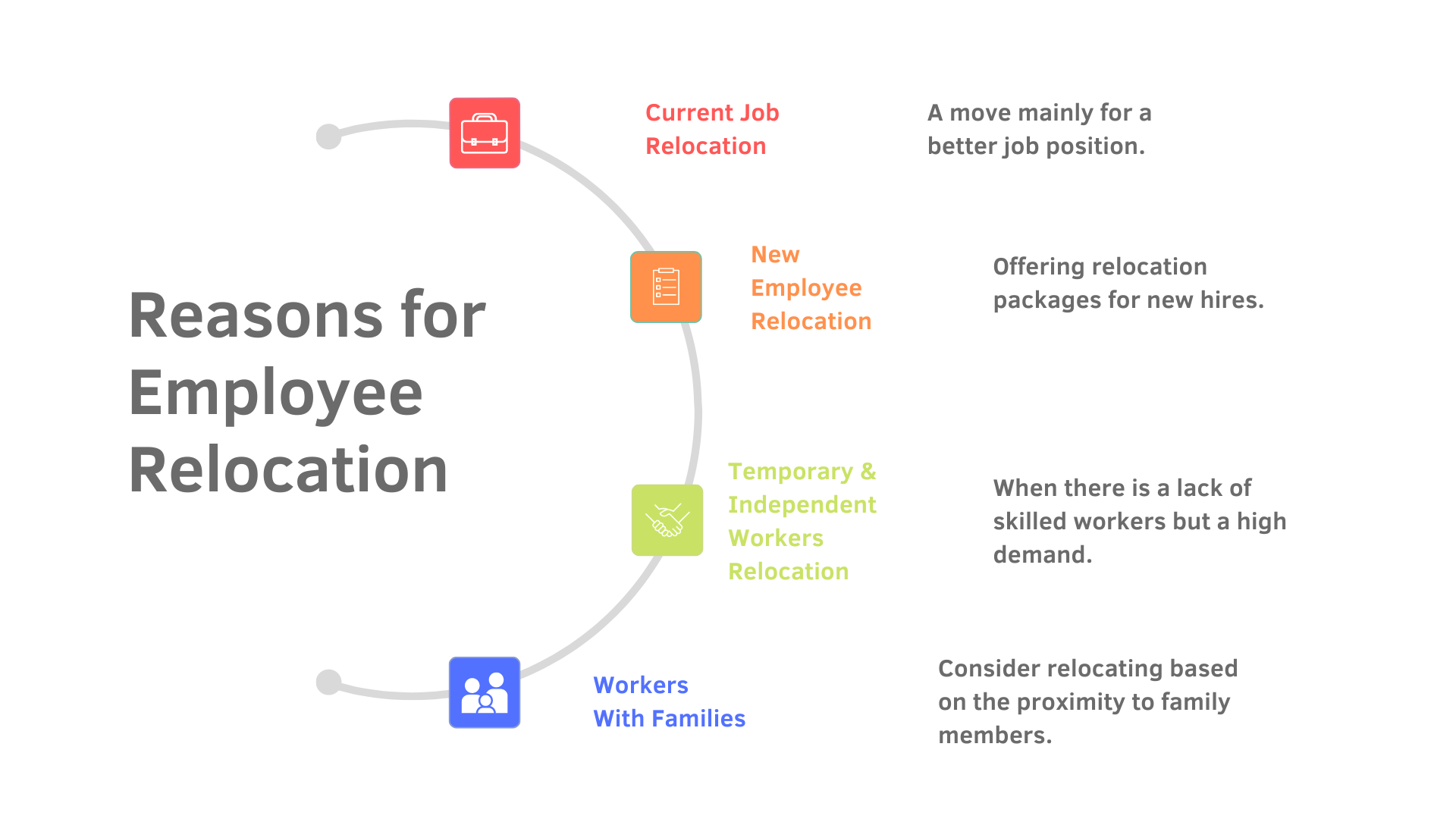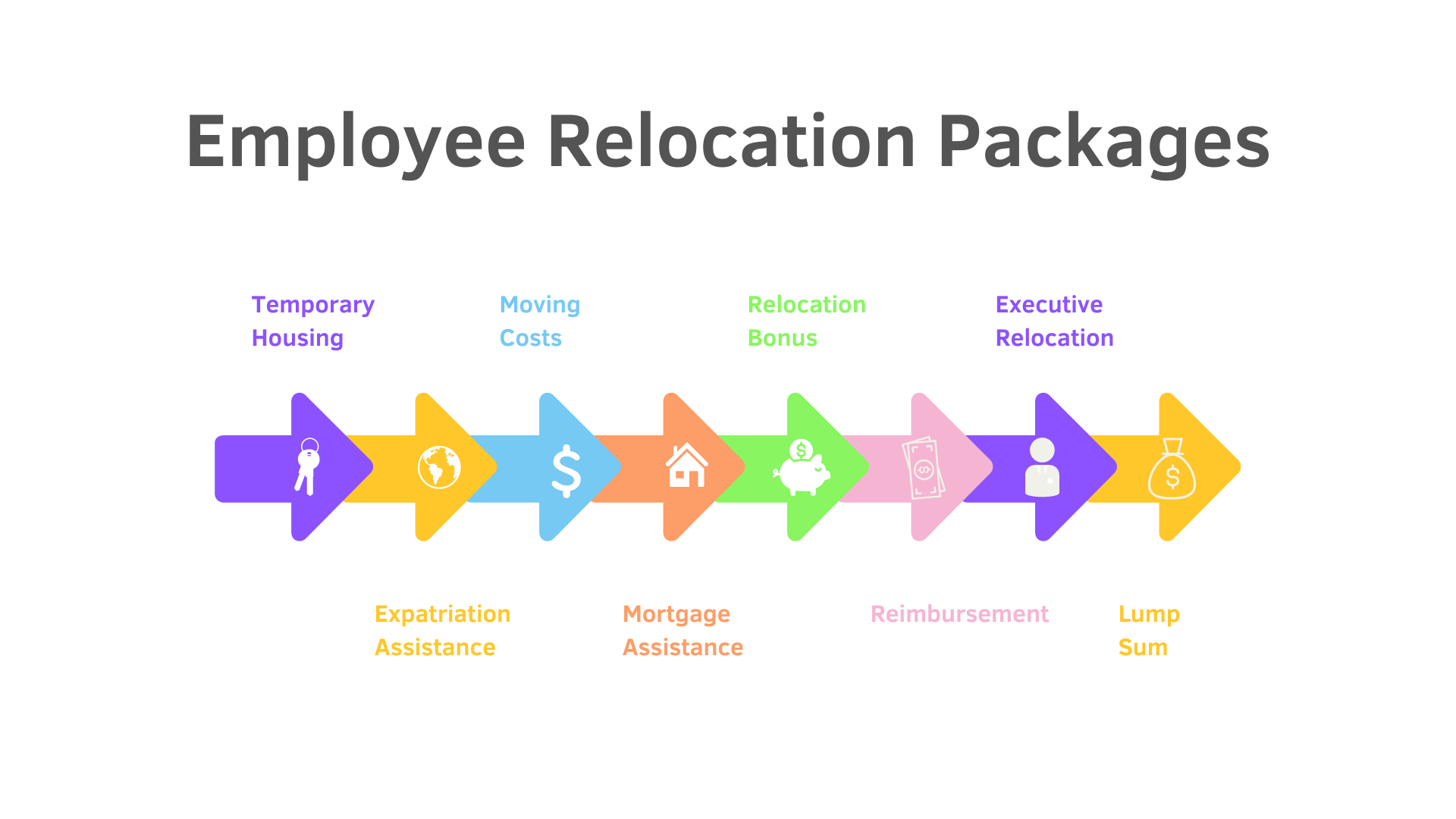
70+ Coworking Statistics & Trends Every Employee Should Know in 2025
Delve into the latest coworking statistics highlighting its benefits in creating a positive work environment and increasing employee productivity.

Opening a new office, answering an employee’s request to move, or opting for the best talent for an open position – there are many reasons for relocating employees.
However, only successful employee relocation leads to a lower turnover rate, greater talent acquisition, and more development opportunities within the company.
Thus, understanding employee relocation is vital.
Employers and HR teams should learn what kind of corporate programs and relocation services are needed and how to implement them through a written relocation policy to support equal opportunities across the board instead of leaving space for favoritism.
Simply put, employee relocation happens when an employee moves to another location within the same company. The relocation can be to a different satellite office in the same city but also abroad.
The main difference lies within the intent of the relocation – when the employee initiates the move, it is either a voluntary relocation or involuntary when the relocation is an organizational decision.
Moreover, employee relocations can happen when a single worker is moved to another location, or the move can mean relocating the whole office or department.
Often, there is interconnectedness between the reasons behind the move and the types of employee relocation. Thus, some of the most common reasons for relocating employees are as follows:

In many companies, these kinds of employee relocation often mean offering different types of packages and services.
Regarding demographics, a survey by Allied shows that:
Moreover, the same survey shows that workers ages 25-34 are most willing to transfer to another location, as they are most likely to do what’s needed for their professional development and advancement.
Regarding the external factors for relocating in 2022, economic conditions were the most significant reason for moving across companies of all sizes. The second external factor was tightly connected to the “The Great Resignation” phenomenon, or the lack of qualified workers in a particular location.
To make good use of relocating employees and maximize its benefits, a company must have a well-established, written relocation policy as an employee relocation checklist.
Many times, relocation programs differ regarding the position of the employees, their work experience and expertise, as well as the distance of the move.
The length of the worker’s stay in another city or country can be another special circumstance that companies should consider when developing a relocation policy.
A good relocation policy should be designed to follow the relocation process step by step, incorporating any specified deadlines or timelines. The policy should include all expenses for the relocation, such as housing, moving, and travel expenses, and enlist all the support the employer is willing to provide for the employee’s family.
Yet, regardless of the various considerations, once the relocation policy is in place, it should be communicated to employees so everyone can familiarize themselves with it. Then, they can decide whether to move or not after knowing what services they are entitled to.
The total cost a company will have for relocating one or multiple employees or a whole department will depend on many factors.
Some of the most significant factors include the distance of the move, travel expenses, type of housing, family support, and more. Below are some of the most common expenses included in employee relocation services:
Temporary or short-term housing is one of the benefits an employer can provide.
A good relocation policy should set up this kind of housing before the employee moves and arrange the accommodation instead of leaving it as another responsibility for the moving employee.
The company policy usually covers all or some moving costs, including airplane tickets for distant locations, the cost of gasoline, or any expenses for hiring moving teams, regardless of whether they are an in-house team or an outsourced alternative to relocation transportation.
In some cases, companies offer additional relocation bonuses, which may be listed in the relocation policy or be an extra incentive for employees. These can include cost-of-living adjustments and other monetary incentives.
The relocation packages that are offered to high-achieving executives are usually those with the best features and differ from those designed for employees below in the hierarchy.
Companies should communicate these differences transparently to prevent workplace disagreements, divisions, and favoritism.
When the employee transfers to a different country, the company can help by covering visa/passport expenses and providing paid trips to the new destination to find housing, schooling, childcare, etc.
Employee relocation programs can also include help buying and selling homes, especially if the current employee’s house remains unsold within a specified timeframe, or as guidance in securing pre-qualification for a mortgage when purchasing a new house at the new location.
All the expenses for the relocation can be covered as a relocation reimbursement plan that covers all costs based on the receipts provided by the employee.
Compensation for relocation costs is generally provided via lump-sum payment estimated to cover the expenses during the move.

Employee relocations can benefit both employees and organizations when executed professionally, transparently, and based on a well-established policy. The advantages of employee relocation consist of benefits:
Employees can leverage a corporate move to embrace career development opportunities, obtain knowledge transfer and skill enhancement opportunities, get exposed to new environments, improve their living standards, and more.
Some of the most significant benefits employers can have as a direct or indirect result of employee relocation include attracting and retaining talent, ensuring strategic placement of skilled employees, streamlining business expansion, filling positions with qualified workers, introducing cultural diversity in the workplace, and more.
Besides the many pros, a corporate relocation can have its downsides as well. However, to estimate if the implications of an employee relocation are positive or negative for the company, it comes down to whether the financial benefits surpass the associated costs of the job transfer.
Common cons include poor communication, legal issues, and economic factors.
In recent years, employees have been more reluctant to move to another city or country because of work duties, reaching the lowest annual rate of 6.77% for 2018-2020.
This is primarily due to remote work opportunities that don’t necessarily translate to corporate relocations, rising inflation, relocation costs, higher mortgage rates, and more.
The years after the COVID-19 pandemic have propounded this hesitation as working from home became the new norm for many workers, shifting the landscape as we know it.
Thus, companies should opt for compelling relocation packages for employees, often tailored to specific and individual needs according to a well-designed relocation policy to convince workers to move and demonstrate the program’s strategic value.
SEO Manager at Shortlister
Browse our curated list of vendors to find the best solution for your needs.
Subscribe to our newsletter for the latest trends, expert tips, and workplace insights!

Delve into the latest coworking statistics highlighting its benefits in creating a positive work environment and increasing employee productivity.

In the face of a slowdown in hiring, sweeping policy changes, economic uncertainty, and an increase in ghost jobs, securing employment seems more challenging than ever. However, there may still be a silver lining.

In an era of unprecedented corporate power, can we still safeguard the dignity of every worker amid the relentless quest for profit?

Employee background assessments are subject to legal responsibilities under the Fair Credit Reporting Act. What does an FCRA background check mean for employers, and what do they need to know before doing one?
Used by most of the top employee benefits consultants in the US, Shortlister is where you can find, research and select HR and benefits vendors for your clients.
Shortlister helps you reach your ideal prospects. Claim your free account to control your message and receive employer, consultant and health plan leads.